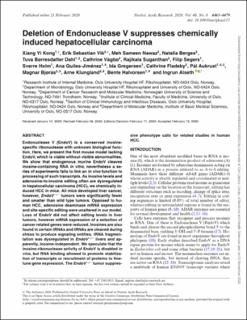| dc.contributor.author | Kong, Xiang Yi | |
| dc.contributor.author | Vik, Erik Sebastian | |
| dc.contributor.author | Nawaz, Meh Sameen | |
| dc.contributor.author | Berges, Natalia | |
| dc.contributor.author | Dahl, Tuva Børresdatter | |
| dc.contributor.author | Vågbø, Cathrine | |
| dc.contributor.author | Suganthan, Rajikala | |
| dc.contributor.author | Segers, Filip | |
| dc.contributor.author | Holm, Sverre | |
| dc.contributor.author | Quiles-Jimenez, Ana | |
| dc.contributor.author | Gregersen, Ida | |
| dc.contributor.author | Fladeby, Cathrine | |
| dc.contributor.author | Aukrust, Pål | |
| dc.contributor.author | Bjørås, Magnar | |
| dc.contributor.author | Klungland, Arne | |
| dc.contributor.author | Halvorsen, Bente | |
| dc.contributor.author | Alseth, Ingrun | |
| dc.date.accessioned | 2020-11-04T09:52:01Z | |
| dc.date.available | 2020-11-04T09:52:01Z | |
| dc.date.created | 2020-10-27T13:06:53Z | |
| dc.date.issued | 2020 | |
| dc.identifier.issn | 0305-1048 | |
| dc.identifier.uri | https://hdl.handle.net/11250/2686315 | |
| dc.description.abstract | Endonuclease V (EndoV) is a conserved inosine-specific ribonuclease with unknown biological function. Here, we present the first mouse model lacking EndoV, which is viable without visible abnormalities. We show that endogenous murine EndoV cleaves inosine-containing RNA in vitro, nevertheless a series of experiments fails to link an in vivo function to processing of such transcripts. As inosine levels and adenosine-to-inosine editing often are dysregulated in hepatocellular carcinoma (HCC), we chemically induced HCC in mice. All mice developed liver cancer, however, EndoV−/− tumors were significantly fewer and smaller than wild type tumors. Opposed to human HCC, adenosine deaminase mRNA expression and site-specific editing were unaltered in our model. Loss of EndoV did not affect editing levels in liver tumors, however mRNA expression of a selection of cancer related genes were reduced. Inosines are also found in certain tRNAs and tRNAs are cleaved during stress to produce signaling entities. tRNA fragmentation was dysregulated in EndoV−/− livers and apparently, inosine-independent. We speculate that the inosine-ribonuclease activity of EndoV is disabled in vivo, but RNA binding allowed to promote stabilization of transcripts or recruitment of proteins to fine-tune gene expression. The EndoV−/− tumor suppressive phenotype calls for related studies in human HCC. | en_US |
| dc.language.iso | eng | en_US |
| dc.publisher | Oxford University Press | en_US |
| dc.rights | Navngivelse 4.0 Internasjonal | * |
| dc.rights.uri | http://creativecommons.org/licenses/by/4.0/deed.no | * |
| dc.title | Deletion of Endonuclease V suppresses chemically induced hepatocellular carcinoma | en_US |
| dc.type | Peer reviewed | en_US |
| dc.type | Journal article | en_US |
| dc.description.version | publishedVersion | en_US |
| dc.source.journal | Nucleic Acids Research | en_US |
| dc.identifier.doi | 10.1093/nar/gkaa115 | |
| dc.identifier.cristin | 1842594 | |
| dc.description.localcode | © The Author(s) 2020. Published by Oxford University Press on behalf of Nucleic Acids Research. This is an Open Access article distributed under the terms of the Creative Commons Attribution Non-Commercial License (http://creativecommons.org/licenses/by-nc/4.0/), which permits non-commercial re-use, distribution, and reproduction in any medium, provided the original work is properly cited. For commercial re-use, please contact journals.permissions@oup.com | en_US |
| cristin.ispublished | true | |
| cristin.fulltext | original | |
| cristin.qualitycode | 2 | |

